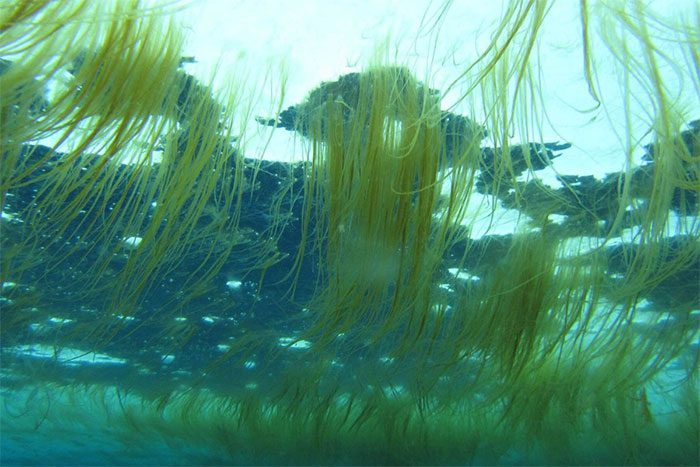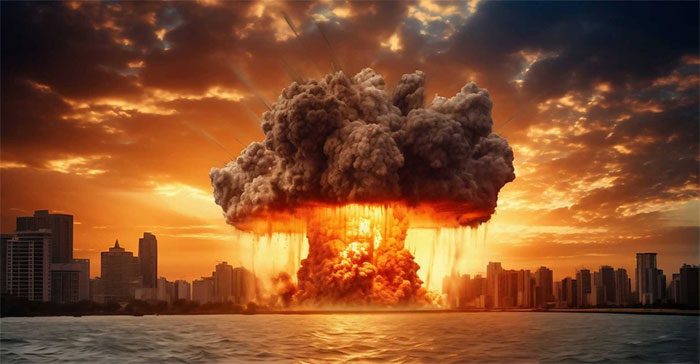In the event of a nuclear war, the Earth would experience an endless winter, and humanity would face unprecedented famine.
Researchers believe that the survival of those who endure a nuclear conflict depends on their ability to cultivate algae.
A nuclear war would plunge the Earth into a prolonged winter, referred to by scientists as a nuclear winter. When atomic bombs explode, millions of tons of soot are released into the atmosphere, obscuring sunlight.
Studies suggest that a nuclear war between the United States and Russia could lower the average temperature of our planet by up to 9°C.
The consequences would nearly eliminate agricultural production, and survivors of the bomb blasts would face deadly starvation.

Scientists reveal a potential resource that could save humanity in the event of a nuclear war. (Illustrative image: Futura Science).
Algae as Food in the Event of Nuclear War
An international research team may have just discovered a solution to this dilemma. This was published in the journal Earth’s Future.
According to their findings, algae should be cultivated on farms, not only as a food source for humans and animals but also for fuel production.
This is because algae can withstand conditions in tropical seas, even after a nuclear conflict.
The researchers focused on a species of algae known scientifically as Gracilaria tikvahiae. It requires only a few photons to perform photosynthesis.
In the event of a nuclear war, scientists believe that the tropics at noon would still receive 20 times the number of photons necessary for growth.
Therefore, algae could sustain over a billion people after just nine months of enhanced production. However, a minor downside is that this organism contains high levels of iodine, and excessive iodine intake can be hazardous to the thyroid.
This somewhat limits the amount of algae that can be incorporated into our diets.
However, algae are also rich in proteins, vitamins, essential amino acids, and fatty acids. Although algae would absorb many pollutants in the case of a nuclear war, simple processing methods can sufficiently reduce these contaminants.
We can be assured that algae could contribute to global food security. Other studies indicate that a nuclear war would also have devastating effects on our oceans.
The World Would Be Devastated If Russia and the U.S. Engaged in Nuclear Conflict
In a hypothetical scenario, after detecting an attack, ballistic missiles from a U.S. submarine off the west coast of Norway would begin targeting Russia. Ten minutes later, Russia’s ballistic missiles from northern Canada would also launch towards the United States.
Initially, they would strike electronic devices and power grids by generating electromagnetic pulses of tens of thousands of volts. Following that, ballistic missiles would target command centers and nuclear launch facilities.

A nuclear war will have no winners, only losers. (Illustrative image).
Intercontinental ballistic missiles launched from the ground take about half an hour to reach their targets. Major cities would be among the first areas to suffer, as they house military facilities, command centers, and would hinder the enemy’s post-war recovery.
Each impact would create a fireball with temperatures equivalent to the core of the Sun, followed by a radioactive mushroom cloud.
The fireball would “vaporize” everything nearby, blinding witnesses and igniting fires. When nuclear missiles explode, they would generate a massive shockwave, strong enough to “crush” nearby buildings.
NATO’s Article 5 states that any armed attack against one or more members of the alliance is considered an attack against the entire alliance, and all members will support the victims of such an attack immediately.
This means that if Russia launches a nuclear attack on the United States, it would also target the United Kingdom and France, as these are two nuclear-capable nations obligated to protect the U.S.
Firestorms would engulf many cities, and winds would fan the flames, incinerating everything: glass, certain metals, while melting asphalt into a flammable liquid.
Research also indicates that the explosions, electromagnetic pulses, and radiation are not the worst aspects; the truly terrifying consequence is nuclear winter, formed by the black carbon smoke from nuclear explosions.
The atomic bomb dropped by the U.S. on Hiroshima (Japan) during World War II caused a nuclear winter, but today’s nuclear bombs are far more powerful, and the aftermath is something none of us want to contemplate.
A major city like Moscow (Russia), with a population nearly 50 times that of Hiroshima, would see countless fatalities from a nuclear bomb.
Simultaneously, it would generate immense amounts of carbon smoke, and firestorms would propel this black smoke into the stratosphere, where it would persist without anything to disperse it.
This black smoke would then be heated by sunlight, floating like a balloon for a decade and only taking a few minutes to spread across much of the Northern Hemisphere.
This would cause the Earth to become freezing cold even in summer. Scientists estimate that the repercussions would cool agricultural land in Kansas (U.S.) by 20 degrees Celsius, while other regions would drop nearly twice as much.
5 billion people could die of starvation, including 99% of the population living in the U.S., Europe, Russia, and China.
The presence of black carbon lingering in the Northern Hemisphere for decades would cause significant temperature drops, rendering agriculture unable to produce.
Clearly, we cannot know how many people would survive a nuclear war. But if it is as dire as research predicts, a nuclear war will have no winners, only losers.


















































